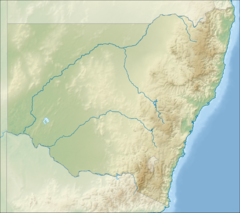Gulaga National Park
| Gulaga National Park | ||
|---|---|---|
| Mount Gulaga and the Tilba settlement | ||
|
|
||
| Location: | New South Wales , Australia | |
| Specialty: | Lookout point over the coast | |
| Surface: | 46.73 km² | |
| Founding: | January 2001 | |
The Gulaga National Park is a national park in the southeast of the Australian state of New South Wales . The park was created in January 2001 and is 46.73 km² in size.

The park, which is also called Mount Dromedary , is located northwest and southwest of Wallaga Lake and also includes the former Wallaga Lake National Park . In Wallaga Lake is the Merriman Island , which is of great importance for the myths of the Aborigines who are not allowed to enter. It is the focus of Aboriginal culture, as the island is linked to the story of King Merriman, who is well known among the Yuin Aboriginal people on the south coast of New South Wales. The Elder Umbarra , also known as King Merriman, also lived on the island .
From Mount Dromedary, which can be reached on old mining roads, the coast from Narooma to Bermagui can be seen. For the local Aborigines , especially for the women, Mount Dromedary has a mystical meaning. On May 6, 2006, the land rights to Biamanga National Park and Gulaga National Park were returned by the government of New South Wales to the Yuin Aboriginal tribe .
Individual evidence
- ^ Gulaga National Park - Park Management . Office of Environment & Heritage. NSW National Parks and Wildlife Service
- ↑ Gulaga National Park - Park Details . Office of Environment & Heritage. NSW National Parks and Wildlife Service

